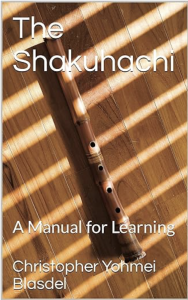Posts in Category: English News
The Shakuhachi: A Manual for Learning now available on Amazon Kindle
 The e-book version of The Shakuhachi, A Manual for Learning, one of the first comprehensive English-language shakuhachi instruction books, is now available on Amazon Kindle at the significantly reduced price of $9.99. Originally published in 1986 by Ongaku no Tomo-sha, Japan’s leading music press, The Shakuhachi has undergone numerous editions and helped many beginner and intermediate players learn more about the instrument and how to play it. This book covers all the basic aspects of learning the shakuhachi, beginning with a chapter on bamboo and shakuhachi making, how to handle the instrument, tone production, as well as basic fingering and Kinko style ornamentation techniques. Also included in the book are a series of graduated shakuhachi practice exercises, from simple tunes to some of the lofty classical sankyoku pieces. These exercises, along with recorded examples, are also available for free download.
The e-book version of The Shakuhachi, A Manual for Learning, one of the first comprehensive English-language shakuhachi instruction books, is now available on Amazon Kindle at the significantly reduced price of $9.99. Originally published in 1986 by Ongaku no Tomo-sha, Japan’s leading music press, The Shakuhachi has undergone numerous editions and helped many beginner and intermediate players learn more about the instrument and how to play it. This book covers all the basic aspects of learning the shakuhachi, beginning with a chapter on bamboo and shakuhachi making, how to handle the instrument, tone production, as well as basic fingering and Kinko style ornamentation techniques. Also included in the book are a series of graduated shakuhachi practice exercises, from simple tunes to some of the lofty classical sankyoku pieces. These exercises, along with recorded examples, are also available for free download.
You can view the Amazon site here.
My vintage CDs uploaded to CD Baby Pro
 The Night of the Garuda (1986) features such stellar musicians as master ryūteki (gagaku flute) performer Shiba Sukeyasu, shō player Miyata Mayumi, vocalist Kimula Mika, legendary shamisen player the Hirai Sumiko and the oud master Hamsa el Din. The tracks consist of:
The Night of the Garuda (1986) features such stellar musicians as master ryūteki (gagaku flute) performer Shiba Sukeyasu, shō player Miyata Mayumi, vocalist Kimula Mika, legendary shamisen player the Hirai Sumiko and the oud master Hamsa el Din. The tracks consist of:⦿ Night of the Garuda—improvisation with shakuhachi and ryūteki.
⦿ Tsuki, for shakuhachi and shō (composed by Massumoto Kikuko)
Song of Atitlan–for shakuhachi and voice.
⦿ Hifumi Hachigaeshi–Kinko-ryū shakuhachi honkyoku.
⦿ Mama no Kawa–Jiuta: song, shamisen and shakuhachi.
⦿ In the Shadow of the Rose—Improvisation for shakuhachi and oud (this piece originally appeared on the CD Voices from Afar, Voices from Within).
The list of accompanists includes some of the most amazing musicians active in Japan at the time. Some are no longer with us, so I take this opportunity to share their music once more. Check out the following site for purchasing or sample listening.
 Zen Reveries (1996), a collaboration between shakuhachi and synthesizer, was originally produced by Moonbridge, a small indie label, and was one of the first such collaborations between these two totally different instruments. The synthesizer is performed by the Japanese electronic music pioneer Uehara Kazuo, and through his delicate harmonies and melodies the insistent voice of the shakuhachi weaves in an out, responding to the vast array of warm, complex timbres created by the synthesizer. The result is the best of both the electronic and the acoustic. Please check it out on the following website:
Zen Reveries (1996), a collaboration between shakuhachi and synthesizer, was originally produced by Moonbridge, a small indie label, and was one of the first such collaborations between these two totally different instruments. The synthesizer is performed by the Japanese electronic music pioneer Uehara Kazuo, and through his delicate harmonies and melodies the insistent voice of the shakuhachi weaves in an out, responding to the vast array of warm, complex timbres created by the synthesizer. The result is the best of both the electronic and the acoustic. Please check it out on the following website:
The Single Tone now available as an Ebook on Amazon Kindle
Since it has been long out of print, I have reformatted “The Single Tone—A Personal Journey into Shakuhachi Music” into an e-book format, and it is now offered on Amazon for Kindle, I-Pads, I-Phones and other electronic devices. It is also available on Apple E-books.
“The Single Tone” is both an autobiography and a guidebook: a coming of age story woven into a study of Japanese music, told by an expatriate American in Japan, where I lived from 1972 until 2016, studying, performing and teaching shakuhachi and Japanese music.
I wrote the original Japanese version to provide an outsider’s view of the Japanese society in a style and voice that would interest the average Japanese reader. It must have struck a chord with its intended audience, because it was awarded the prestigious Ren’nyo Award for non-fiction and published by Kawade Shobō Publishers in Spring, 2000, selling out soon after publication. The English version, first published in 2005, is a close translation of the Japanese, with some minor additions and clarifications of circumstances, situations and cultural contexts that might not be apparent to the non-Japanese reader. In the brand new E-book version, I have have added a few more photos and exchanged most of the black and white photos of the print version with color photos. The cost is $9.99. (By the way, someone is selling used copies of the print edition on Amazon for over $50, so make sure you access the Kindle version page.) You can order directly from Amazon here. Or Apple Books here.
Some of the comments for The Single Tone
“Shakuhachi music is honest, profound and beautiful. Blasdel has the passion and spirit that embodies these characteristics and is a pioneer who faces both the Japanese and world community in order to invite others to participate in this extraordinary music.”
Yokoyama Katsuya, shakuhachi performer (1934-2010)
“Blasdel’s insights are a goldmine for culture studies and ethnomusicology scholars considering cross-cultural interaction and learning.”
Dr. Ricardo D. Trimillos, Professor Emeritus (Ethnomusicology), the University of Hawai’i
“In The Single Tone, Blasdel explores the contradictions inherent in the study of traditional Japanese music by an outsider. He demonstrates that humanity supersedes even the strongest cultural barriers when philosophy and love of music are the guides.”
Brian Ritchie, bassist for Violent Femmes, shakuhachi performer
“Blasdel’s love and passion for the shakuhachi permeate the work, but the most interesting thing about the book are his observations on the Japanese culture.”
The Asahi Shimbun Newspaper, Tokyo
